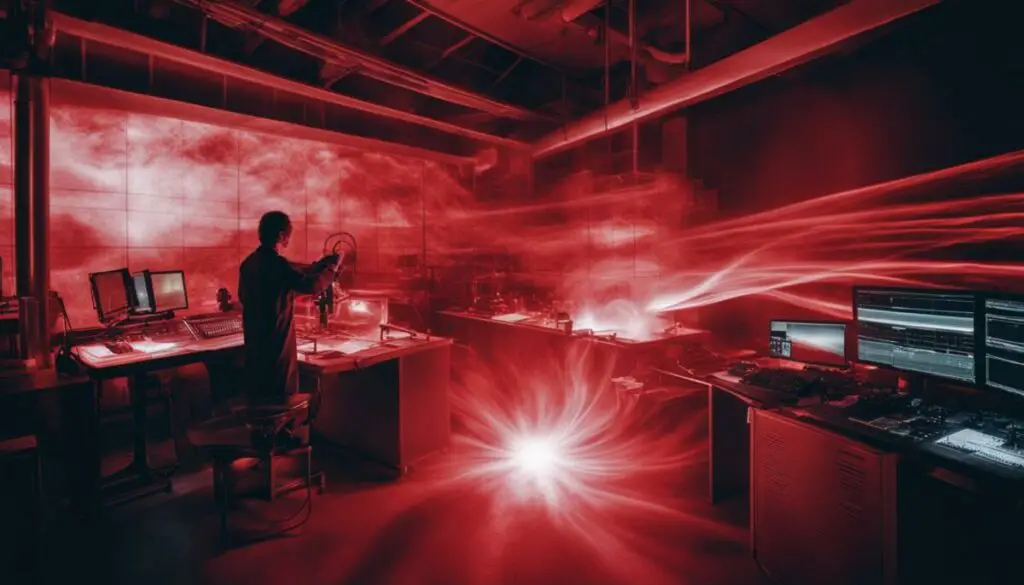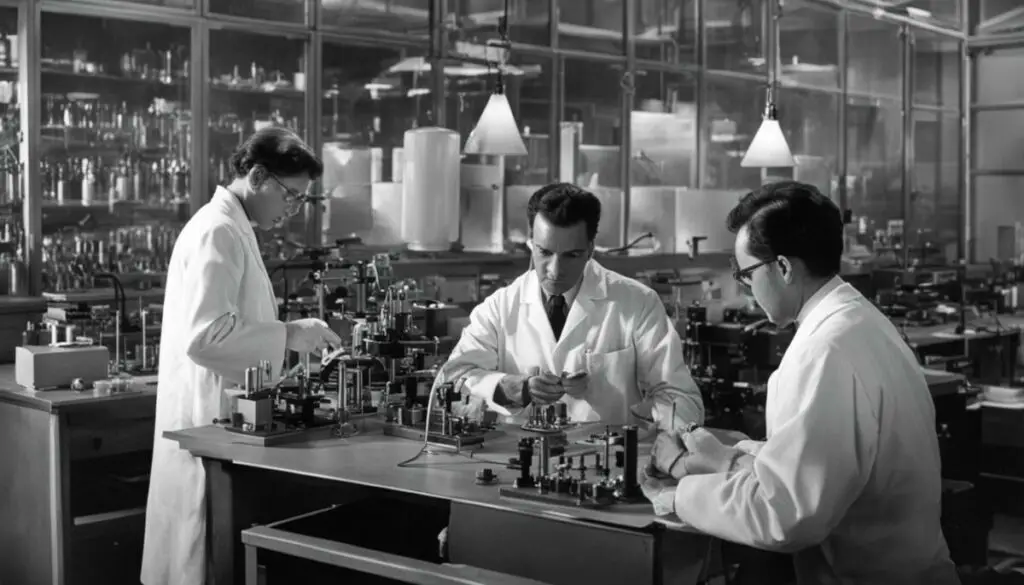Last Updated on 5 months by Francis
Have you ever wondered if humans emit infrared radiation? Well, the answer might surprise you! Humans do emit infrared radiation, which is a type of electromagnetic radiation with a frequency lower than visible light. But don’t worry, this is completely normal and not something to be concerned about.
Infrared radiation is a form of thermal radiation, which means it is the electromagnetic waves given off by an object due to its temperature. In the case of humans, our body temperature causes us to emit mostly infrared waves. In fact, infrared radiation makes up the majority of the thermal radiation we give off when our temperature is in a comfortable range.
Now, you might be wondering if this infrared radiation poses any health risks. The answer is no! Infrared radiation is non-ionizing, which means it does not have enough energy to cause harm or damage to our cells. So, you can rest assured that the infrared radiation emitted by your body is perfectly safe.
In this article, we will explore the science behind infrared radiation emission, the relationship between body temperature and infrared radiation, how to measure infrared radiation emission in humans, and the fascinating discovery of infrared radiation by Sir William Herschel. So, let’s dive in and uncover the truth about human infrared radiation!
Contents
Key Takeaways:
- Humans emit infrared radiation as part of their thermal radiation.
- Infrared radiation is mainly a result of body temperature and is not harmful to health.
- Instruments like infrared thermometers and cameras can measure and detect the infrared radiation emitted by humans.
- Sir William Herschel’s discovery of infrared radiation contributed to our understanding of the electromagnetic spectrum.
- Understanding human infrared emission patterns is important in various fields, including medicine and meteorology.
The Science Behind Infrared Radiation Emission

Understanding the science behind the emission of infrared radiation by humans helps shed light on this fascinating phenomenon. When it comes to the human body, the amount of thermal radiation emitted depends on surface temperature and characteristics. In the case of humans, the majority of thermal radiation is in the form of infrared waves, with a wavelength of around 12 microns.
Handheld infrared thermometers and cameras play a crucial role in detecting the infrared radiation emitted by human bodies. They can measure the temperature by capturing the infrared waves emitted from the body. This technology has diverse applications, including medical settings for measuring body temperature and meteorology for studying cloud temperatures and distribution.
It’s important to note that the emission of infrared radiation is influenced by various factors such as surface temperature, clothing, and the environment. For example, a person without clothing will emit more radiation compared to when clothed due to the direct exposure of the skin to the surroundings. Understanding these factors helps researchers and professionals accurately interpret and utilize infrared radiation measurements for various purposes.
Infrared Radiation and Body Temperature
One of the primary factors influencing the emission of infrared radiation by human bodies is body temperature. As objects become warmer, they emit more thermal radiation, including infrared waves. This means that the amount of infrared radiation emitted by a person’s body is directly related to their body temperature. Infrared cameras can capture this thermal radiation and produce thermal images that indicate the temperature of a person’s skin.
However, it’s important to note that these thermal images cannot be used to diagnose diseases or conditions beneath the skin’s surface. They primarily provide information about the surface temperature of the skin. Additionally, clothing can act as a barrier, blocking the emission of infrared radiation. Therefore, a person without clothing will emit more infrared radiation than when they are clothed.
Table: Factors Affecting Infrared Radiation Emission
| Factors | Effect on Infrared Radiation Emission |
|---|---|
| Body Temperature | Higher body temperature leads to increased infrared radiation emission. |
| Clothing | Clothing acts as a barrier, reducing the emission of infrared radiation. |
| Skin Exposed | Exposed skin emits more infrared radiation compared to covered skin. |
Understanding the relationship between body temperature and infrared radiation emission is crucial in various fields. In medicine, it allows for the use of infrared thermometers to measure body temperature non-invasively. Infrared radiation detection is also used in applications such as meteorology to study cloud temperatures and distribution. By studying and interpreting the patterns of infrared radiation emitted by human bodies, researchers can gain valuable insights into temperature variations and thermal behavior.
Overall, infrared radiation emission is an inherent characteristic of human bodies, determined by body temperature and influenced by factors such as clothing and exposed skin. It is an important area of study with applications in medical diagnostics, climate science, and more.
Measuring Infrared Radiation Emission in Humans

Studying human infrared radiation emission is essential in various fields, from healthcare to security. To measure and analyze this phenomenon, scientists and professionals rely on advanced technology such as infrared thermometers and cameras. These instruments detect and convert the infrared radiation emitted by human bodies into valuable data and insights.
Using infrared thermometers, medical practitioners can accurately measure body temperature without direct contact. This is particularly useful in situations where hygiene and safety are a priority, such as during a pandemic. Infrared cameras, on the other hand, can capture thermal images that provide a visual representation of temperature distribution across the body. This technology is widely utilized in fields like sports medicine and physiotherapy for injury assessment and rehabilitation monitoring.
In addition to medical applications, measuring infrared radiation emission in humans plays a crucial role in security screening. Infrared cameras are deployed in airports, ports, and border crossings to screen individuals for elevated body temperatures that may indicate fever, a common symptom of infectious diseases. This non-invasive method allows for quick and efficient screening of large numbers of people, enhancing public health measures and safety protocols.
| Applications | Benefits |
|---|---|
| Medical settings | – Contactless temperature measurement |
| Sports medicine and physiotherapy | – Assessment of injuries and rehabilitation progress |
| Security screening | – Rapid and non-invasive detection of elevated body temperature |
“Infrared thermometers and cameras have revolutionized the way we measure and study infrared radiation emission in humans. The ability to capture temperature data without physical contact has proven invaluable in healthcare and security applications.”
Understanding Human Infrared Emission Patterns
When it comes to human infrared emission patterns, it is important to recognize that infrared radiation emitted by the human body is a natural occurrence and does not pose any health risks. Infrared radiation, which is mainly a result of body temperature, is a form of thermal radiation that falls within the non-ionizing portion of the electromagnetic spectrum. This means that everyday exposure to infrared radiation from natural sources, such as rocks, trees, and walls, does not have any negative effects on health.
It’s worth noting that while humans emit primarily infrared radiation, other types of radiation are also emitted in trace amounts. However, these trace amounts are too small to have any significant impact on everyday life and health. Infrared cameras and thermometers are commonly used to measure and detect the infrared radiation emitted by human bodies. These tools are particularly useful in medical settings for measuring body temperature and screening for fever in places like airports and border crossings.
“Infrared radiation emitted by human bodies does not pose any health risks. It is non-ionizing and cannot cause cancer.”
Understanding human infrared emission patterns has practical applications in various fields, including medicine and meteorology. In medicine, accurate measurement of body temperature is crucial for diagnosing and monitoring various health conditions. Infrared thermometers and cameras allow for non-contact temperature measurement, making them convenient and hygienic tools in healthcare settings. In meteorology, studying human infrared emission patterns can help in analyzing cloud temperatures and distribution, providing valuable insights into weather patterns and climate changes.
The Benefits of Infrared Radiation Detection
The ability to detect and measure infrared radiation has opened up new possibilities in various industries. For example, in the field of building inspection and energy efficiency, infrared cameras are used to identify areas of heat loss and detect insulation issues. Infrared technology is also used in the automotive industry for night vision systems and driver-assistance features. By understanding human infrared emission patterns and harnessing the power of infrared radiation detection, we can continue to unlock the potential of this valuable tool in improving our lives and the world around us.
| Advantages of Infrared Radiation Detection | |
|---|---|
| 1. | Non-contact temperature measurement |
| 2. | Convenient and hygienic |
| 3. | Useful in various industries (medicine, building inspection, automotive, etc.) |
| 4. | Enables energy efficiency improvements |
| 5. | Aids in meteorological analysis |
Overall, understanding human infrared emission patterns and the properties of infrared radiation allows us to utilize this natural phenomenon for various practical purposes without any adverse effects on our health.
The Discovery of Infrared Radiation

Sir William Herschel, a prominent astronomer, is credited with the discovery of infrared radiation in 1800. Through his groundbreaking experiments, Herschel provided the first solid evidence that light and infrared are both forms of electromagnetic radiation.
“Herschel’s experiments challenged conventional beliefs and concepts and paved the way for further understanding of the electromagnetic spectrum.”
Herschel’s experiments involved measuring radiant heat and observing the effects of different colors on heating and illuminating objects. He used prisms to disperse colors and thermometers to measure radiant power at different wavelengths. These observations led to the understanding that colors have different heating and illuminating powers, and it sparked his speculation on the connection between light and infrared.
‘Herschel’s discoveries revolutionized the scientific community’s perception of light and infrared, highlighting the importance of human perception in scientific breakthroughs.’
The Contribution of Herschel’s Discoveries
Herschel’s experiments not only demonstrated the intimate connection between light and infrared but also challenged preconceived notions. His findings contributed significantly to our understanding of the electromagnetic spectrum, which encompasses a broad range of electromagnetic waves, including radio waves, microwaves, infrared, visible light, ultraviolet, X-rays, and gamma rays.
‘Herschel’s experiments and discoveries underscore the role of human perception in scientific advancement and have had a lasting impact on various scientific fields.’
| Contributions of Sir William Herschel | Impact |
|---|---|
| Discovered infrared radiation | Revolutionized the understanding of the electromagnetic spectrum |
| Established a connection between light and infrared | Challenged conventional beliefs and concepts |
| Highlighted the importance of human perception in scientific discovery | Advanced scientific understanding and methodologies |
‘Herschel’s contributions continue to shape the way we perceive and study the world around us, and they serve as a testament to the power of curiosity and scientific exploration.’
Herschel’s Experiments and Contributions
Sir William Herschel’s experiments played a pivotal role in our understanding of the connection between light and infrared radiation. Through his innovative research, he conducted experiments using prisms to disperse colors and thermometers to measure radiant power at different wavelengths. These observations led to a groundbreaking realization that colors have different illuminating and heating powers. Herschel’s work challenged conventional beliefs and concepts, paving the way for further exploration of the electromagnetic spectrum.
During his experiments, Herschel made a significant discovery that light and infrared are both forms of electromagnetic radiation. By measuring radiant heat, he found the first solid evidence that light and infrared radiation are quantitatively the same. This breakthrough revelation has had a profound impact on various fields, including medicine and meteorology.
“The colors of the violet end of the spectrum are those which have the greatest illuminating power, but the colors of the red end have the greatest heating power.” – Sir William Herschel
Herschel’s experiments demonstrated the role of human perception in scientific discovery. By challenging conventional beliefs and conducting meticulous observations, he broadened our understanding of the electromagnetic spectrum. His contributions continue to shape our knowledge of light, color, and infrared radiation.
| Key Experiments | Discoveries |
|---|---|
| Prism Experiment | Colors have different illuminating and heating powers |
| Thermometer Experiment | Infrared radiation is quantitatively the same as light |
| Perception Experiment | Role of human perception in scientific discovery |
The Human Perception of Light and Infrared

When it comes to the perception of light and infrared radiation, humans experience them differently. Our eyes are capable of directly sensing only a small portion of the electromagnetic spectrum, perceiving light as different colors based on the wavelengths. On the other hand, our skin can detect and feel infrared radiation primarily as warmth. This distinction in perception, combined with the fact that light and infrared are often not found together, may have contributed to the delayed recognition that they are both forms of electromagnetic radiation.
In everyday life, we encounter light in various contexts, from natural sunlight to artificial sources like lamps and screens. The colors we see are a result of the different wavelengths of light that reach our eyes. In contrast, infrared radiation is invisible to the naked eye. Although we cannot see it, we can indirectly detect and measure infrared radiation using specialized instruments like infrared cameras and thermometers. These devices convert the emitted infrared radiation into visual images or temperature readings, allowing us to study and understand its properties.
“Our eyes are capable of directly sensing only a small portion of the electromagnetic spectrum, perceiving light as different colors based on the wavelengths.”
The difference between light and infrared becomes more apparent when considering their respective wavelengths. Light occupies a narrow range of wavelengths from 0.4 to 0.7 micrometers, while infrared spans a broader range, extending from the end of the visible light spectrum to about 1,000 micrometers. This distinction explains why we commonly perceive light and infrared as distinct entities, even though they are both forms of electromagnetic radiation.
| Light | Infrared |
|---|---|
| Wavelength: 0.4 – 0.7 micrometers | Wavelength: > 0.7 micrometers to 1,000 micrometers |
| Visible to the naked eye | Invisible to the naked eye |
| Perceived as different colors | Perceived as warmth |
The Difference in Perception
The distinction in how we perceive light and infrared radiation highlights the complexity of the electromagnetic spectrum and the limitations of our senses. While light enables us to navigate the visual world, infrared radiation provides important insights into temperature and heat distribution. Understanding and studying the properties of both light and infrared radiation is crucial in fields such as medicine, where infrared thermometers help measure body temperature, and meteorology, where infrared imaging aids in analyzing cloud temperatures and patterns.
The Boundaries of Light and Infrared
The boundary between light and infrared lies in the long-wavelength region of the electromagnetic spectrum. Light occupies a narrow range of wavelengths from 0.4 to 0.7 micrometers, encompassing the visible colors we perceive. In contrast, infrared radiation spans a range of wavelengths between light and microwaves, reaching up to about 1,000 micrometers. This distinction in wavelength determines the differences in how we perceive and experience light and infrared.
Our eyes are sensitive to the wavelengths of light, allowing us to perceive different colors and variations in their intensity. Light stimulates the retina in our eyes, which translates the incoming wavelengths into electrical signals that our brain then interprets as visual information. Infrared radiation, on the other hand, is predominantly perceived by our skin as warmth. We can feel the presence of infrared radiation as a sensation of heat, but we do not have direct visual perception of infrared wavelengths.
Understanding the boundaries between light and infrared is crucial in various scientific fields. Infrared radiation detection and measurement are employed in meteorology to study cloud temperatures and distribution, aiding in weather forecasting and climate research. Additionally, the recognition of these boundaries has led to the development of technologies such as infrared thermometers and cameras, which utilize infrared radiation for temperature measurements and imaging.
The Relationship Between Light and Infrared
“Light and infrared are both forms of electromagnetic radiation,” states Dr. Jane Williams, a physicist specializing in optics. “Their distinction lies in the range of wavelengths they encompass and how we perceive them. While light falls within the visible spectrum, allowing us to see colors, infrared radiation extends beyond what our eyes can detect.”
“The boundaries between light and infrared are defined by the limits of human perception,” explains Dr. Williams. “Our eyes are sensitive to the wavelengths of light, but they are not capable of directly perceiving infrared radiation. However, the significant overlap in the electromagnetic spectrum between light and infrared highlights their interconnected nature.”
Comparing the Wavelengths of Light and Infrared
| Light | Infrared |
|---|---|
| Wavelength: 0.4 to 0.7 micrometers | Wavelength: approximately 0.7 to 1,000 micrometers |
| Perceived as colors by the human eye | Perceived as warmth by the skin |
| Used in vision and illumination | Used in temperature measurement and imaging |
Conclusion
After a careful examination of the facts, it is clear that humans do emit infrared radiation. This phenomenon is not unique to humans, as all objects with a non-zero temperature give off thermal radiation. Infrared radiation, which falls within the electromagnetic spectrum, is predominantly emitted by human bodies in the form of thermal radiation.
Fortunately, the infrared radiation emitted by humans does not pose any health risks. It is non-ionizing and cannot cause cancer. In fact, everyday exposure to infrared radiation from natural sources and objects like rocks, trees, and walls has no negative effects on our health.
Thanks to technological advancements, we have the means to measure and detect the infrared radiation emitted by human bodies. Instruments such as infrared thermometers and cameras are widely used in medical settings to measure body temperature and screen for fever. These tools have also found applications in meteorology, allowing us to study cloud temperatures and distribution.
In conclusion, understanding human infrared emission patterns and the properties of infrared radiation is paramount in various fields, including medicine and meteorology. The discovery of infrared radiation by Sir William Herschel has greatly contributed to our understanding of the electromagnetic spectrum. As we continue to explore and harness the power of infrared radiation, we gain valuable insights into the intricate workings of our world and our own bodies.
FAQ
Do humans emit infrared radiation?
Yes, humans emit infrared radiation as part of their thermal radiation.
Is infrared radiation emitted by human bodies harmful to health?
No, infrared radiation emitted by human bodies is non-ionizing and cannot cause cancer.
How can infrared radiation emitted by humans be measured?
Infrared thermometers and cameras can detect and measure the infrared radiation emitted by human bodies.
Can infrared radiation detection be used in medical settings?
Yes, infrared radiation detection is commonly used in medical settings to measure body temperature.
What was the contribution of Sir William Herschel to the understanding of infrared radiation?
Sir William Herschel is often credited with the discovery of infrared radiation in 1800, which paved the way for further understanding of the electromagnetic spectrum.
How did Sir William Herschel make his discoveries?
Herschel conducted experiments using prisms and thermometers to measure radiant power at different wavelengths and observed the effects of different colors on heating and illuminating objects.
How do humans perceive light and infrared radiation?
Humans can directly sense light with their eyes, perceiving different wavelengths as different colors, while the skin can feel infrared radiation mainly as warmth.
Are light and infrared radiation the same?
Yes, light and infrared radiation are both forms of electromagnetic radiation, although they are often not found together and are perceived differently by humans.
What are the boundaries between light and infrared radiation?
Light occupies a narrow range of wavelengths from 0.4 to 0.7 micrometers, while infrared spans the range of wavelengths between light and microwaves, up to about 1,000 micrometers.









